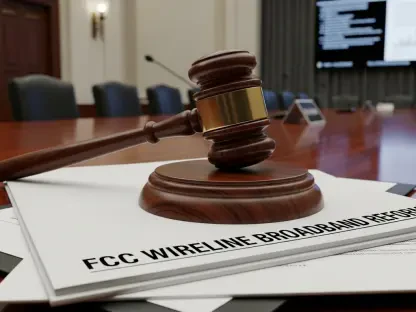The challenge of reducing government waste and optimizing spending, now spearheaded by the Department of Government Efficiency (DOGE) initiative under the Trump administration, continues to be a pivotal issue. Directed by entrepreneurial heavyweight Elon Musk and financier Vivek Ramaswamy, this initiative seeks to cut redundant expenditures and streamline government operations. This endeavor arrives at a crucial time when inflation continuously impacts American families, necessitating a revisitation and optimization of government expenditure to align it with efficiency and accountability.
Aligning public spending with a reformed approach is critical against the backdrop of a persistent inflationary environment. Government financial discipline is not just a theoretical exercise but a real necessity to ensure taxpayers’ money is used prudently and effectively. Historically, efforts to curb wasteful expenditure have faced numerous obstacles, shedding light on the deep-rooted challenges in achieving lasting fiscal efficiency. Delving into these historical attempts offers a comprehensive understanding of those persistent hurdles and the potential impact of modern strategies.
Historical Attempts at Government Efficiency
A look back at various presidential administrations reveals a recurring focus on forming committees to tackle government waste reduction, dating all the way back to the pre-World War II era. The Hoover Commission, initiated by President Harry Truman and named after former President Herbert Hoover, stands out as a notably successful effort. This commission generated over 250 recommendations to Congress, with nearly 70% being put into action. This resulted in a significant streamlining of several government agencies that had expanded during World War II, effectively demonstrating that when focus and goals are aligned, substantial progress is achievable.
However, not all efforts have been as fruitful. A contrasting example can be seen with the Reagan administration’s Grace Commission, established in 1982. It convened 36 task forces chaired by 161 business sector leaders who collectively made around 2,500 recommendations aimed at slashing federal spending by approximately $424 billion over three years. Nevertheless, critical reviews raised questions about conflicts of interest and the applicability of private sector efficiency rules to public sector operations. Additionally, only about 27% of these recommendations could be enforced through executive orders, with the rest requiring congressional approval that was ultimately not forthcoming. Consequently, the initiative failed to achieve its intended impact, and by the end of Reagan’s administration, both the national deficit and debt had tripled.
Political and Constituent Interests
The historical efforts illuminate a vital lesson: the persistent difficulty in overcoming political and constituent interests rooted in budgetary allocations. These vested interests form a significant barrier to effective reform as any move towards budget reductions typically meets resistance when it endangers the interests of politicians’ supporting constituencies. For instance, eliminating farm subsidies would hardly gain favor with senators from farm states, just as efforts to reduce green energy initiatives would face opposition from states with significant stakes in these programs, like Colorado.
A new facet of the current Musk-led initiative is the strategic use of social networks, particularly X (formerly known as Twitter), to influence public opinion and garner support for budget reforms. Leveraging this modern tool could prove instrumental in engaging public participation on an unprecedented level and rallying collective backing for budget cuts. The initiative draws inspiration from the success of the Hoover Commission, which engaged the public through local chambers of commerce. Similarly, DOGE aims to utilize media platforms to highlight government inefficiencies, thereby exerting public pressure on political decision-makers.
Risks and Challenges of Modern Approaches
Despite its promising aspects, the modern approach brought by Musk’s initiative presents inherent risks, notably the potential for undue influence by a vocal minority over the essential needs and safety nets that a majority depend on. Foundational government services, such as clean water, safe food systems, and emergency services, are critical, and ensuring they retain funding amidst proposed cuts is complex. This complexity underscores the importance of having elected officials who can balance these concerns prudently and make informed decisions that prioritize public welfare.
The article highlights an overarching consensus that current government spending rates are unsustainable, reflecting an urgent need for budget reforms. Historical patterns of reform efforts reveal a common outcome where successes are temporary and limited due to entrenched political interests and the intricate nature of federal budgeting. However, the article suggests that the Trump administration, through DOGE and influential figures like Musk, might introduce a transformative dimension by harnessing the power of modern communication and public engagement.
The Role of Public Engagement and Media
The effort to reduce government waste and optimize spending, now led by the Department of Government Efficiency (DOGE) initiative under the Trump administration, remains a critical concern. Guided by entrepreneur Elon Musk and financier Vivek Ramaswamy, this initiative aims to cut unnecessary expenditures and streamline government operations. This effort comes at an essential time when inflation is placing a growing strain on American families, highlighting the need to revisit and optimize government spending for increased efficiency and accountability.
Addressing public spending with a new approach is vital in an ongoing inflationary environment. Ensuring government financial discipline is not a mere academic exercise but a necessity to guarantee that taxpayers’ money is used wisely. Historically, attempts to reduce wasteful spending have encountered various challenges, demonstrating the entrenched difficulties in achieving sustainable fiscal efficiency. Examining these past efforts helps to understand the persistent obstacles and the potential impact of modern strategies on enhancing government financial management.









